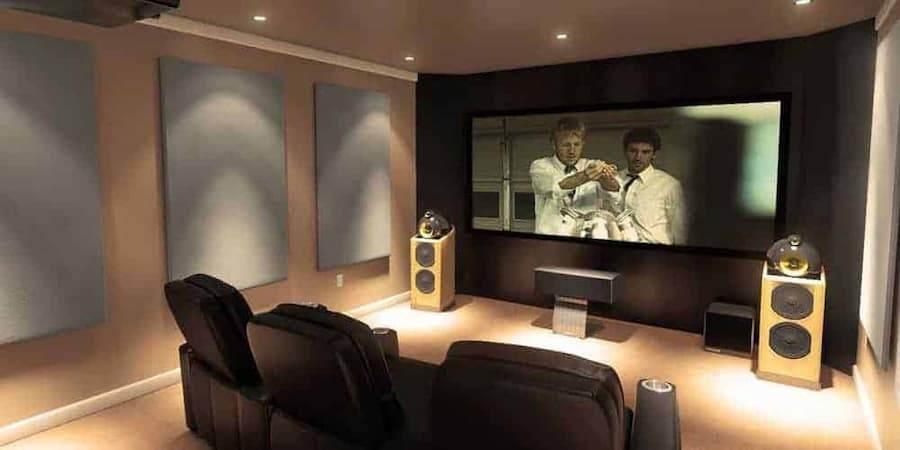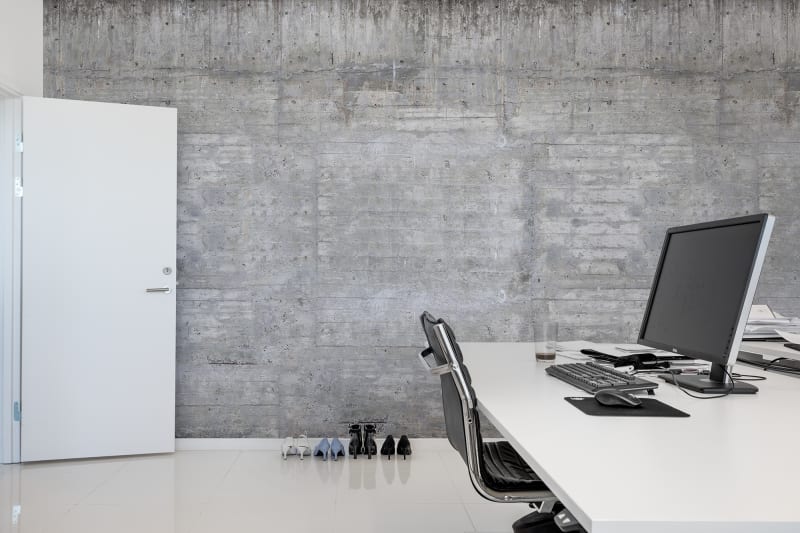How to Soundproof a Home Theater
It’s 11:00 on a chill Saturday night. Your partner has just gone to bed, and you can’t wait to watch The Godfather, a classic 1900’s movie that has been restored and redone in 5.1 surround sound. The terrible foot pounding from above begins seconds after the picture blasts into the opening tune.
Your supposed chill time is done before it even begins. Frustrated, you decide to fix this problem by soundproofing the family room that also serves as your home theater once and for all. But how to soundproof a home theater? Have you ever wondered how much it costs to soundproof a home theater, media room, or man cave? Perhaps you’re planning to build a new house or an expansion to fit your dream theater and want to include effective sound isolation as part of the project. Worry no more, we’ve got you covered!

Determine the Amount of Necessary Soundproofing
The first step is to evaluate how much soundproofing is required in the theater room. Some people only want a small amount of soundproofing to improve the sound quality. Others want to make the theater as private as possible, making it comparable to a typical public movie theater.
The process will be more expensive the more essential full soundproofing is to a person. A theater room can have a wide range of noises, from as low as 10 dB to as high as 110 dB (learn more about decibels on silencewiki.com).
Soundproofing a room well enough to hear the faintest whispers of the movie or show you’re watching is difficult. It’s also difficult to keep an explosion from echoing throughout the house. After determining how much soundproofing you will need, consider the next step. Determining the key ingredients of soundproofing.
Key Ingredients of Soundproofing
The best soundproofing results are achieved by combining these key ingredients and materials listed below in the correct order.
| 1.Mass | Sound waves are hampered by mass, therefore adding mass to a structure will make it more difficult for them to vibrate. Sound absorption qualities of brick, thick glass, concrete, and metal can be increased by adding density; layers of drywall. This is a good way to reduce sound transmission, especially at higher frequencies. |
| 2.Damping | The reduction of vibrational energy produced by sound waves is known as damping. It’s more effective with lower-frequency ranges, so it’s a great compliment to more mass. |
| 3.Decoupling | In a solid structure, sound always follows the path of least resistance. The decoupling approach involves isolating struts and panels in order to impede sound waves and reduce their intensity. |
| 4.Absorption | The process by which sound energy is dissipated rather than reflected by a substance or an object is called absorption. While the absorption technique does not completely eliminate noise, it does muffle it and is best used in conjunction with other soundproofing techniques. |
How to Soundproof a Home Theater
Pre-Construction
While soundproofing during the construction of a home theater is normally a tertiary consideration, it will save time, money, and effort. It minimizes reverberation and cancels annoying noise seeping into other sections of the home, resulting in better audio inside the room.
| 1.Walls | The first step is to add acoustic insulation or soundproof batting to the freshly constructed wall. Make sure the insulation fits firmly between the studs and completely fills the space; any gaps cause an air leak, which leads to noise transmission via the air. Insulation clips help to hold the material in place and produce better results. To seal every gap, use a good grade damping caulk like Green Glue (official website). To help prevent air leaks, cover electrical outlets with putty pads. Not only would adding a layer of MLV or comparable material enhance density, but it will also impart damping qualities. Sound waves cannot pass through the thick yet flexible material, which provides a reflected sound barrier. |
| 2.Door | Although hollow interior doors are less expensive, they provide limited sound and vibration protection. We strongly advise you to get a solid core door to assist reduce noise transfer! Another easy and efficient approach for keeping sound in and undesirable noise out is weatherstripping. It’s just a thin, self-adhesive roll of foam that sits around the door frame and absorbs sound waves. If you use green glue to apply it, it will have much more sound dampening characteristics. It just takes a few minutes to install a door sweep, which effectively closes the greatest gap of all, the one between the bottom of the door and the floor. We recommend installing a rod above the entrance to hang a thick, sound-dampening curtain is a good idea for home theaters! When the theater is in use, they merely need to be drawn over the door, leaving the door completely accessible at all other times. |
| 3.Ceiling | Isolated studs make sound transmission difficult; by spacing them out, you may prevent sound waves from choosing the route of least resistance. Consider utilizing soundproofing drywall sheets while putting up the ceiling. It’s created in the same way as regular drywall, but it’s denser, which enhances sound absorption. It is the more costly alternative, but it will surely pay off in the long run! Alternatively, you can install a double-layer of conventional drywall, making sure to seal every connection and gap. Both approaches increase mass, which reduces impact and noise in the air. |
| 4.Windows | If at all possible, avoid installing windows in your home theater; not only does glass allow in light, but it is the most difficult to soundproof. If you want to know more about soundproofing a window, click here. If you have no other option and the room will be used for several purposes, double-pane windows should be installed as soon as possible. If money isn’t an issue, go with a triple pane or laminated glass. While laminated glass might be expensive, it pays for itself since it efficiently deadens 95 percent of soundwaves. |
Video: Sound Dampening a Home Theatre room – HOW TO INSTALL SONOPAN
Post-Construction
If you want to build a home movie theater in an existing space, you’ll need to use the least amount of soundproofing materials and procedures possible. When you use a combination of these methods, you can get better outcomes!
| 1.Walls | There are different techniques to soundproof an existing wall: 1. Adding more drywall/green-glue layers will improve density and prevent sound waves from migrating into adjacent rooms. 2. To dampen and reflect sound waves, a layer of MLV (Mass Loaded Vinyl) can be applied underneath a drywall layer. 3. Filling insulation into the existing wall. This material is made out of low-density cellulose, which serves to reduce soundwave transmission. 4. Acoustic panels are a popular choice since they don’t require any building and are quick and easy to install. They increase the acoustics while also reducing echo (more info about soundproofing materials on silencewiki.com). |
| 2.Ceiling | Suspended ceilings employ the decoupling method of soundproofing, which involves a separation between the primary and secondary ceilings. The use of insulation between the layers aids in the absorption of much of the impact as well as some airborne noise. Sound waves can also be suppressed by isolating existing joints, although this would need extensive building work. A new layer of drywall, or better yet, soundproof drywall, can be added to an existing ceiling. As a result of the increased density, noise difficulties are reduced. Always use a damping caulk to seal all joints and frames. Although it is straightforward to glue acoustic foam to an existing ceiling, it is not the most aesthetically pleasing solution (13 methods of soundproofing a ceiling on soundproofliving.com). |
| 3.Doors | If replacing a hollow-core door with a solid core door isn’t an option, there are a few additional options! Sound waves are absorbed and insulated by weatherstripping. The huge gap at the bottom of the door is covered with door sweeps. Sound waves can pass through if air and light can. They are low-cost and easy to install. Additionally, if you want to block off light, insulate, and absorb unwanted sound, use heavy and thick drapes. |
| 4.Windows | If the room you’ve designated for your home theater has windows, consider eliminating them if at all possible. If it isn’t an option, invest in double/triple pane or laminated glass instead. Sound-proofing drapes, thick and heavy, should be used to cover the windows. Consider using soundproofing materials such as MDF, acoustic foam, MLV, and green glue to install/create a window plug. |
| 5.Floor | Existing floors may be soundproofed in a variety of ways, the majority of which include soft or absorbent materials. Because of its inherent sound absorption capabilities, carpet is the most typical floor covering in home theaters. But, don’t just settle for this, there are further ways to improve the carpet’s performance! Consider putting one of these ways to the subfloor before installing carpet: 1. MLV is a low-cost, dense, and flexible material. Once attached to the floor, it will outperform carpet alone in terms of sound absorption. 2. Soundproofing Underlayment, simply putting thicker underlayment provides better outcomes. 3. Due to its sponge-like structure, neoprene, the synthetic rubber used to produce wetsuits, is excellent at absorbing both impact and airborne sound. 4. If a wall-to-wall carpet is not practicable, thick rugs can be used to absorb part of the noise. Hard flooring should be avoided if at all possible! |
Video: How to Soundproof a Home Theatre Room
In Conclusion
There is definitely a way to make a home theater a reality with the correct materials and a positive mindset! Don’t be scared to research which strategies work best and how they could work in an individual’s home. When it comes to accomplishing the goals they set out to achieve, some people will be more successful than others.
Soundproofing is, in the end, a learning process too! To get a sense of the effect, start with something small yet useful. After that, look at some of the other options available before deciding on the ideal one. Now, you can watch the best movies in your home theater without any interruption!



